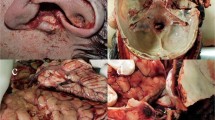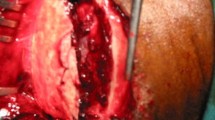Summary
Contrecoup fractures of the base of the skull are regarded as rare in the clinical literature.
In our material (n=171 falls on the same level and on or from stairs), the overall frequency of contrecoup fractures of the anterior cranial fossa in fatal cranio-cerebral trauma due to falls was 12%, as compared to 24% with occipital point of impact of the head.
The relationships between the impact site on the head, form of fracture at the point of impact with involvement of the skull cap and/or the base of the skull, coup and contrecoup injuries of the brain, localization of contrecoup fractures in the anterior cranial fossa and the occurrence of monocle and spectacle haematomas display a major variability.
Fractures occur in the form of simple fractures and as impression fractures (fracture fragments or fracture boundaries displaced to the inside).
Clinical diagnosis is difficult because of the concealed position of the anterior skull base.
Contrecoup fractures become of forensic medical significance when symptoms of a frontobasal injury occur for the first time after trauma which has occured some time in the past and when the question arises as to the causal connection with the original trauma.
In investigation of living persons, it may be difficult to decide whether haemorrhages in the region of the orbit and its vicinity result from a direct blunt force or derive from fractures of the base of the skull, especially contrecoup fractures.
Similar content being viewed by others
References
Birch-Hirschfeld A (1930) Die Erkrankungen der Orbita. In: Schieck F, A Brückner (eds) Kurzes Handbuch der Ophthalmologie, Vol 3. Springer, Berlin
Boenninghaus HG (1974) Rhinochirurgische Aufgaben bei der Chirurgie des an die Schädelbasis angrenzenden Gesichtsschädels. Arch Oto Rhino Laryng 207: 1–228
Bushe KA, Kuhlendahl H (1979) Basiswissen Neurochirurgie. Hippokrates-Verlag, Stuttgart
Chipault A, Braquehaye J (1895) Fractures indirectes de la base du crane. Arch gen de med 176: 279–296, 394–404, 665–701
Courville CB (1942) Coup-Contrecoup mechanism of craniocerebral injuries. Arch Surg 45: 19–43
Courville CB (1964) Forensic neuropathology. Callaghan & Co, Mundelein, Illinois
Dietz H (1970) Die frontobasale Schädelhirnverletzung. Monographien aus dem Gesamtgebiet der Neurologie und Psychiatrie, Heft 130. Springer, Berlin Heidelberg New York
Dietz H (1971) Die basalen Schädelhirnverletzungen. Langenbecks Arch Klin Chir 329: 528–543
Doepfner K (1912) Die Contrecoup-Quetschung des Hirns und die Contrecoup-Fraktur des Schädels. Dtsch Z Chir 116: 44–68
Duke-Elder S, MacFaul PA (1972) Injuries. In: Duke-Elder S (ed) System of ophthalmology, Vol XIV. The C. V. Mosby Company, St. Louis
Friedberg H (1864) Zur Entstehungsweise und Diagnose der Fractur des Orbitadaches. Arch pathol Anat 31: 344–370
Geserick G, Prokop O (1980) Frakturen der knöchernen Orbita bei stumpfem Schädelhirntrauma als Contrecoup-Verletzung. Jap J Legal Med 34: 569–574
Geserick G, Prokop O (1982) Das Orbita- und Felsenbeinzeichen beim Sturz auf den Kopf. Vortr XII Kongr Int Akad Gerichtliche u. Soziale Med (Wien) Mai 1982, Kongreßband, Verlag H. Egermann, Wien, pp 499–501
Geserick G, Prokop O (1988) Zur Lokalisation von Orbita- und Felsenbeinzeichen im Vergleich zum Ort der Gewalteinwirkung auf den Schädel. Krimin forens Wiss 71/72: 41–43
Geserick G, Prokop O, Kruse CH (1980) Frakturen der knöchernen Orbita bei stumpfem Schädeltrauma mit Contrecoup-Verletzungen. Krimin forens Wiss 39: 53–57
Gurlt E (1898) Geschichte der Chirurgie und ihrer Ausübung, Vol 1. Verlag A Hirschwald, Berlin
Hein PM, Schulz E (1989) Die sturzbedingte Schädelhirnverletzung. Beitr gerichtl Med 47: 447–450
Hippokrates Cit. after Gurlt
Hirsch ChS, Kaufman B (1975) Contrecoup skull fractures. J Neurosurg 42: 530–534
Ipsen W (1898) Die indirekten Orbitadachfrakturen. Inaug Diss, Greifswald
Kley W (1968) Die Unfallchirurgie der Schädelbasis und der pneumatischen Räume. Arch Klin exp Ohr Nas u Kehlk Heilk 191: 405–414
Kocher Th (1901) Hämorrhagische Quetschherde und Contrecoupquetschung. Nothnagels spezielle Pathologie und Therapie, Vol 9, 3. Teil: 296–300
Kraus H (1963) Offene Schädelhirnverletzungen. Wien Klin Wschr 75: 492–494
Kuhlendahl H (1959) Frontobasale Schädelhirnverletzungen und traumatische Liquorfistel. Beitr Neurochir 1: 37–56
Lamprecht J (1987) Komplikationsmöglichkeiten nach unerkannter Frontobasisfraktur. In: Bock WJ, Schirmer M (eds) Differentialdiagnosen in der Neurochirurgie. Urban & Schwarzenberg, München Wien Baltimore
Lenggenhager K (1938) Eine neue physikalische Erklärung des Contrecoup. Schweiz med Wschr 19: 1123–1125
Leopold D (1985) Pathogenese des Schädel-Hirn-Traumas. In: Lang G, Reding R (eds) Schädel-Hirn- und Mehrfachverletzungen. Johann Ambrosius Barth, Leipzig
Leser E (1909) Lehrbuch der Chirurgie, Vol II, 9. Aufl. Verlag G Fischer, Jena
Lignitz E, Geserick G, Patzelt D (1983) Frakturen der inneren Orbita beim Contrecoup — Sektionsbefunde und experimentelle Daten zur Pathogenese. Kongreßbericht 1983 der Deutschen Gesellschaft für Verkehrsmedizin e. V. Unfall- und Sicherheitsforschung Straßenverkehr. Heft 42: 90–92
Lignitz E, Geserick G, Patzelt D (1984) Experimentelle Befunde zum Orbitazeichen beim Contrecoup. Krimin forens Wiss 55/56: 20–22
Lindgren S (1964) Studies in head injuries: Intracranial pressure pattern during impact. Lancet 1: 1251–1253
Lindgren S (1966) Experimental studies of mechanical effects in head injury. Acta Chir Scand (Suppl) 360: 1–100
Lindgren S (1983) Interaction Between the Skull base and the Skull Contents at Impact to the Skull. In: Samii M, Brihaye J (eds) Traumatology of the skull base. Springer, Berlin Heidelberg New York Tokyo
Loew F, Pertuiset B, Chaumier EE, Jaksche H (1984) Traumatic, spontaneous and postoperative CSF rhinorrhea. In: Symon Let al (eds) Advances and technical standards in neurosurgery, Vol 11. Springer, Wien New York, pp 169–207
Messerer O (1885) Ueber die gerichtlich-medicinische Bedeutung verschiedener Knochenbruchformen. Friedreichs Bl f gerichtl Med 36: 81–104
Reimann W, Klein A (1981) Contrecoup-Verletzungen der knöchernen Orbita. Vortr Symp Gerichtliche Medizin, Berlin In: Beiträge zur gerichtlichen Medizin Wiss Schriftenreihe Humboldt Univ zu Berlin: 147–151 (1984)
Reimann W, Prokop O (1976) Vademecum Gerichtsmedizin, 2. Aufl. Verlag Volk u. Gesundheit, Berlin
Schroen FW Chr A (1902) Historisches und Theoretisches zu der Lehre von den Schädelbrüchen speziell den sogenannten Gegenbrüchen. Inaug Diss. Würzburg
Schulz E (1986) Stumpfe und scharfe Gewalt. In: Forster B (ed) Praxis der Rechtsmedizin für Mediziner und Juristen. Georg Thieme Verlag, Stuttgart New York. CH Beck'sche Verlagsbuchhandlung, München
Seiferth LB (1954) Die Unfallverletzungen der Nase, der Nasennebenhöhlen und der Basis der vorderen Schädelgrube. Archiv Ohr usw Heilk u Z Hals usw Heilk 165: 1–98
Sellier K, Unterharnscheidt F (1963) Mechanik und Pathomorphologie der Hirnschäden nach stumpfer Gewalteinwirkung auf den Schädel. H Unfallheilk 76: 1–140
Tilmann O (1902) Über Hirnverletzungen durch stumpfe Gewalt und ihre Beziehungen zu den Brüchen des knöchernen Schädels. Langenbecks Arch klin Chir 66: 750–791
Author information
Authors and Affiliations
Rights and permissions
About this article
Cite this article
Hein, P.M., Schulz, E. Contrecoup fractures of the anterior cranial fossae as a consequence of blunt force caused by a fall. Acta neurochir 105, 24–29 (1990). https://doi.org/10.1007/BF01664853
Issue Date:
DOI: https://doi.org/10.1007/BF01664853




